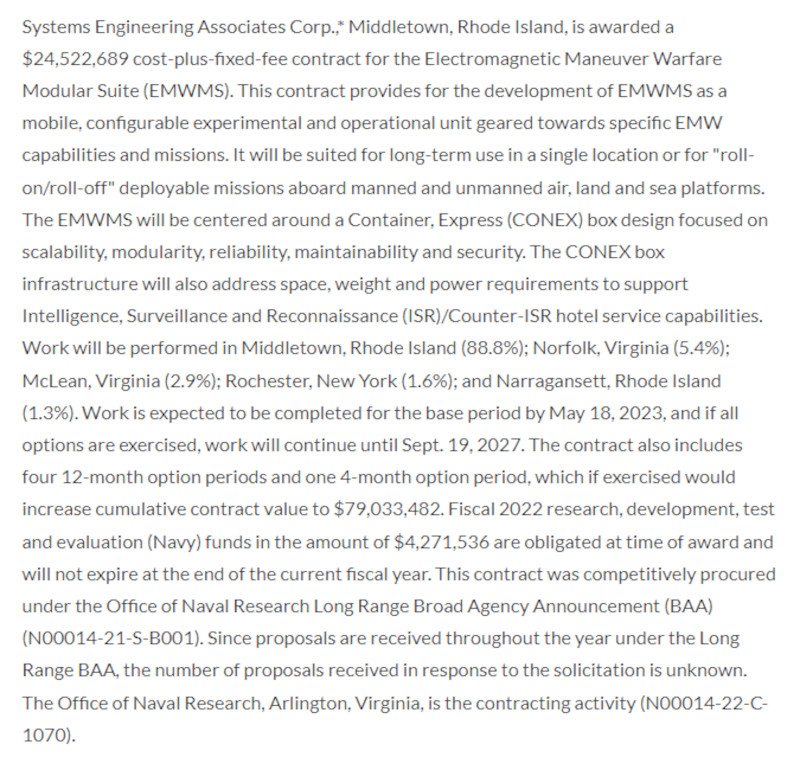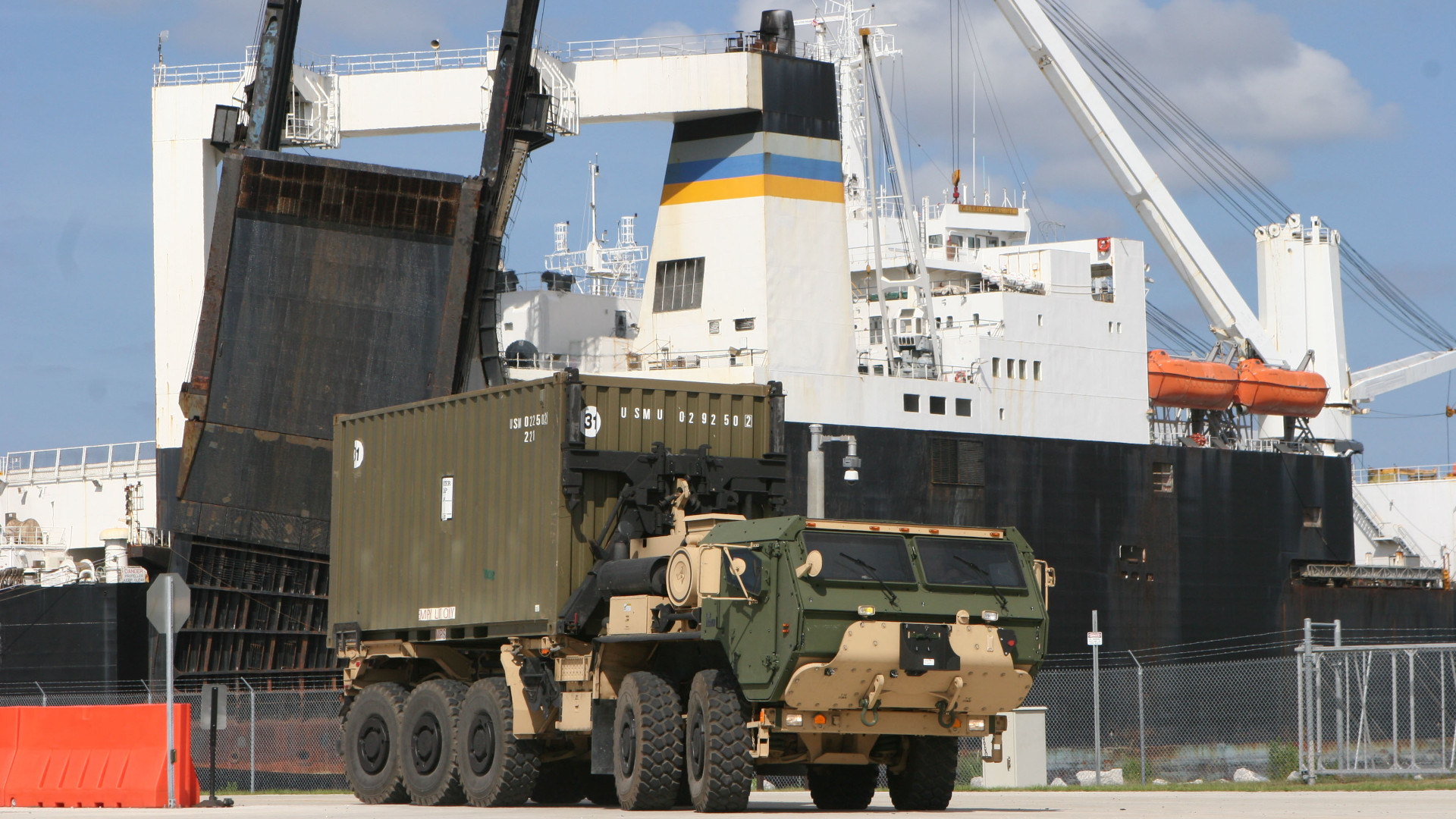The U.S. Navy is working to develop an electronic warfare and electronic intelligence suite that fits inside a standard shipping container. In doing so, the goal is to provide these capabilities in a universal package that could be relatively readily installed, as required, on any platform big enough to carry it, including crewed or uncrewed ships, aircraft, and ground vehicles.
Details about what is called the Electromagnetic Maneuver Warfare Modular Suite (EMWMS) were contained within the Pentagon’s daily contracting notice yesterday. Systems Engineering Associates Corp. has now received a contract from the Office of Naval Research (ONR) worth up to just over $24.5 million for work on the EMWMS.
The EMWMS is intended to be a “mobile, configurable experimental and operational unit geared towards specific EMW capabilities and missions,” according to the contract announcement. “It will be suited for long-term use in a single location or for ‘roll-on/roll-off’ deployable missions aboard manned and unmanned air, land, and sea platforms.”

“The EMWMS will be centered around a Container, Express (CONEX) box design focused on scalability, modularity, reliability, maintainability, and security,” it continues. “The CONEX box infrastructure will also address space, weight, and power requirements to support Intelligence, Surveillance and Reconnaissance (ISR)/Counter-ISR hotel service capabilities.”
There do appear to be any readily available details about EMWMS beyond what is provided in the contract announcement. The War Zone has reached out to ONR for more details.
However, from the description of the system as supporting ISR and counter-ISR requirements, it seems reasonable that it has some degree of electronic warfare (EW) or at least electronic support measures (ESM) capabilities, as well as some form of electronic intelligence/signal intelligence (ELINT/SIGINT) functionality. EW typically refers to attacking signal sources, from radars to communications nodes, through jamming or some other means, while ESM generally is more limited to detecting threat emitters passively and gathering information about them. ELINT/SIGINT has to do with more robust intelligence gathering for further analysis, such as intercepting enemy communications chatter.
It is not uncommon to see systems with some combination of such capabilities, as modern EW/ESM and ELINT/SIGINT suites generally have the ability to not only detect, but locate the positions of signal emitters to varying degrees. With the right array of components, it’s not hard for a complete system to then be able to the ability to jam or spoof those signals, as well as intercept them.
Depending on an EW system’s exact jamming and/or spoofing capabilities, it may be able to provide protection against incoming threats, such as cruise missiles, or be able to knock down hostile drones. Drones, even lower-tier commercial types with improvised munitions, present very real dangers to U.S. forces now and are only likely to become more of an issue as time goes on.

Beyond all this, the geolocation of signal emitters simply helps provide valuable additional situational awareness of the disposition of enemy forces and can also be used to help intelligence analysts build so-called ‘electronic orders of battle‘ to better understand an opponent’s capabilities.
The Navy’s desire for EMWMS to be both modular and scalable would seem to indicate that the suite is expected to be configurable in different ways, perhaps optimized more for EW/ESM or ELINT/SIGINT in certain cases, or with only one set of capabilities, depending on the exact mission requirements. It’s unclear whether the plan is for the various configuration to all fit inside a single CONEX or if a single complete suite might involve systems installed across multiple containers. Of course, even if the idea is for EMWMS to fit inside a single standardized container, this would not preclude the possibility of linking multiple suites together, even via wireless data-link, for added EW/ESM and/or ELINT/SIGINT capacity.
This modularity and scalability could give the suite immense flexibility and operational utility, and is even more interesting to consider given the stated desire for the system to be completely platform agnostic. The contracting announcement indicates EMWMS could leverage its containerized design to be more readily transportable, and then employed from a fixed operational location, as well.
Just within the Navy, there are a host of potential platforms available now, including various crewed amphibious warfare and non-combat logistics ships with significant open deck space, such as its San Antonio class landing ships, Lewis B. Puller class expeditionary sea bases, and Spearhead class fast transports. The Navy has been exploring the ability of these ships and others to accept various modular, potentially containerized payloads, including weapon systems, as ways its capacity to provide various kinds of support during future operations.

There is also the Navy fleet of larger uncrewed surface vessels, something it hopes to expand in the future. The service has already demonstrated a containerized missile launching system aboard the uncrewed surface vessel (USV) Ranger, something you can read more about here, and has been talking for years now about the possibility of adding EW capabilities to its USVs.
When it comes to USVs, the Navy would have to address concerns about operational risks arising from loading containers full of potentially sensitive electronics onto entirely uncrewed vessels. These fears have come to the forefront just recently with the brief seizure of Navy Saildrone USVs by Iranian forces in two separate incidents in the Persian Gulf and the Red Sea. Though the service stressed that these drone boats contained only commercial technology, a subsequent report from The Wall Street Journal that Iran had ripped out cameras on them before returning them highlights the exact issues at play. When it comes to EMWMS, one solution might simply be to use it in a downgraded configuration in combination with USVs.
As a containerized, roll-on, roll-off suite, a version of EMWMS could potentially work onboard the Navy’s C-130 Hercules transport aircraft, too. If the suite can be loaded onto Navy C-130s, it should all but certainly be compatible with Air Force Hercules transports, as well as that service’s C-17A Globemaster III cargo planes.
It is important to note that the aerial employ of a system like this would all but certainly require some additional modification to the aircraft in question, particularly with regard to finding a way to integrate the required antennas. That being said, the Air Force for many years maintained a roll-on, roll-off SIGINT suite for use on the C-130, called Senior Scout. This system consisted of a shipping container-sized mission package that went inside the aircraft’s main cargo bay, along with arrays of antennas installed in place of the rear paratrooper doors on either side of the rear fuselage. Senior Scout was employed operationally in various locales around the world as part of the Global War on Terror, as well as in other preceding conflicts, but has since been retired.

It is also worth noting that experimentation involving Air Force cargo aircraft configured to act as impromptu strike platforms has raised questions about how realistic it might be on a broader level to employ planes like this for other roles in any sort of major conflict where there would be high demand for airlift capacity.
It’s certainly not hard to see how the Marines Corps, as well as the Air Force and Army, might be interested in variants of EMWMS, too. Both of these services have been working to expand their ground-based and airborne EW and SIGINT capabilities, but a significant gap in this regard remains between the U.S. military and its potential adversaries, especially Russia and China. The threats posed by enemy EW systems have become particularly pronounced for U.S. ground forces, something that is now often reflected in major training exercises.
A containerized EW/ESM and ELINT/SIGINT system could offer Americn troops on the ground some degree of protection against electromagnetic spectrum threats, as well as a way to launch non-kinetic attacks and otherwise glean important information about their opponents. As such, a system like EMWMS that could be readily installed on one of a number of existing tactical truck types could be a very attractive way to help close the capability gap.
As already noted, the U.S. military isn’t the only one interested in capabilities like this, either. Just last week, a report from the Izvestia newspaper in Russia, which cited anonymous defense industry sources within the country, said that the Russian Navy is looking into a containerized EW system that could be employed on various ships. This system is said to be primarily focused on protecting vessels by jamming radar seekers on incoming anti-ship missiles. This of course follows a number of significant Russian naval losses in the Black Sea at the hands of Ukrainian forces in the current conflict between those two countries, most notably the sinking of the Black Sea Fleet’s flagship Moskva in April.
It remains to be seen when, and in what form or forms, EMWMS might ultimately enter service with the U.S. Navy or elsewhere within the U.S. military. At the same time, from what we know now, the core concept at least sounds both viable and potentially very valuable when paired with various ships, aircraft, and ground vehicles.
Contact the author: joe@thedrive.com
